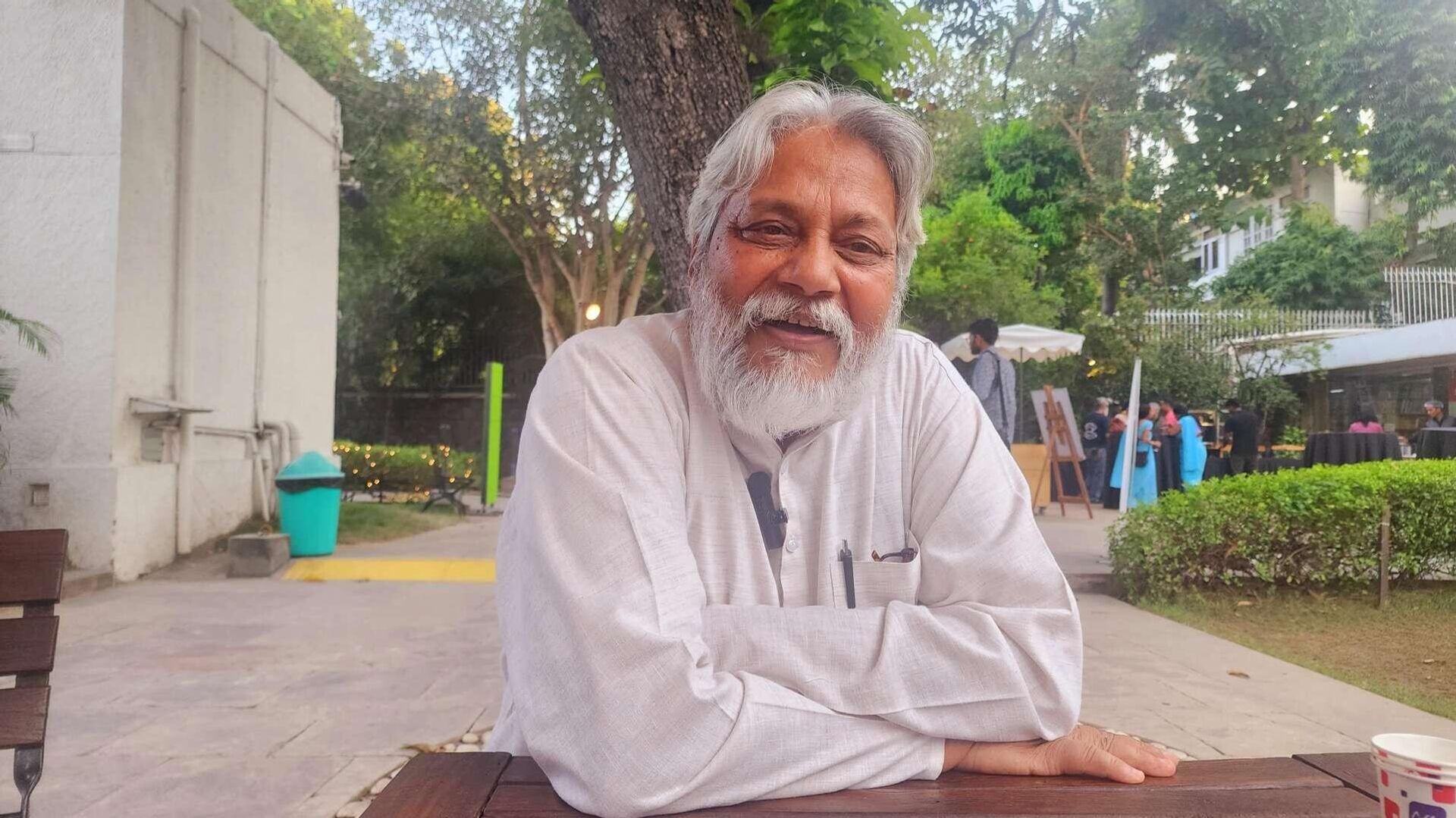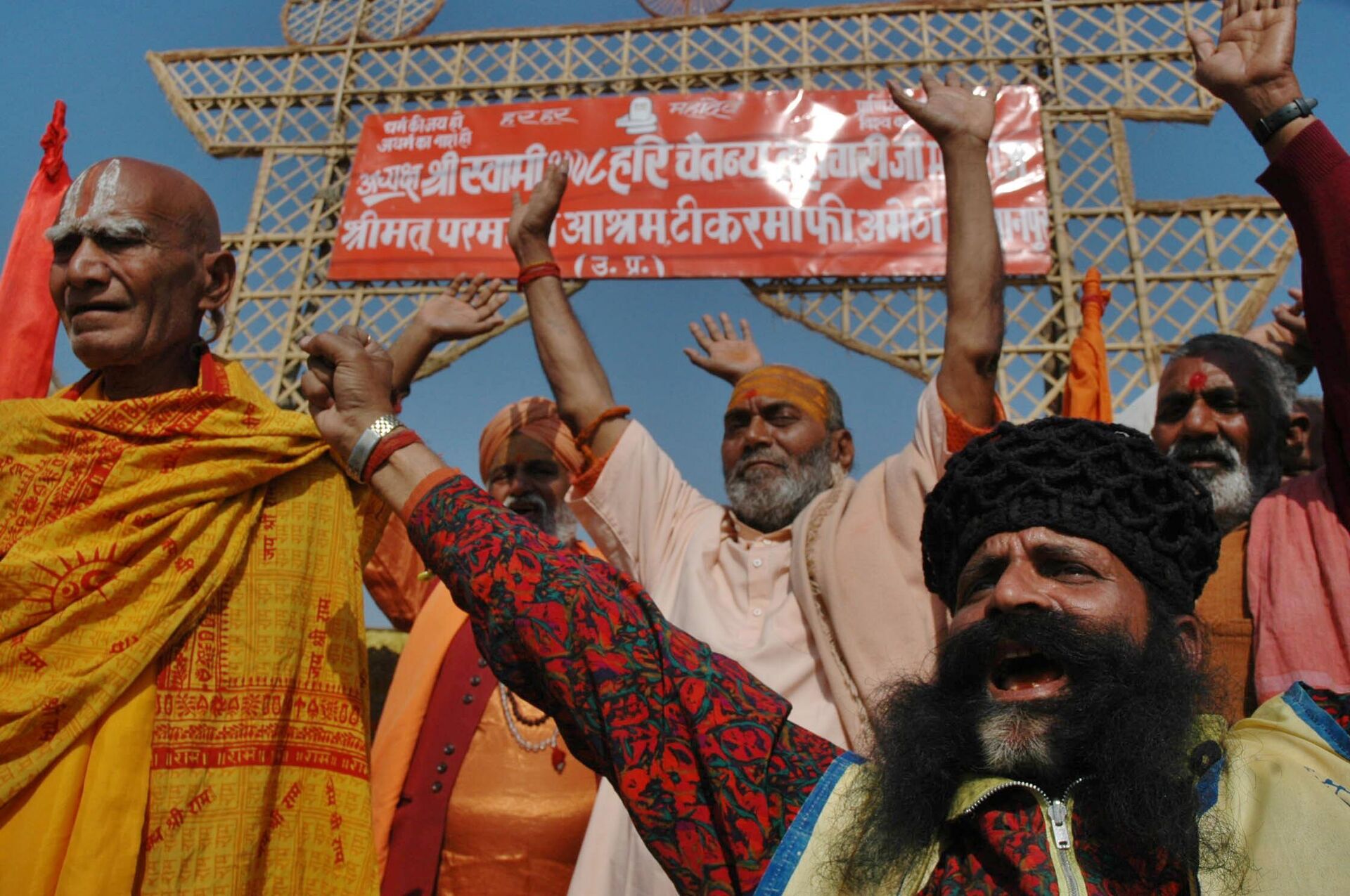https://sputniknews.in/20231017/meet-doctor-waterman-of-india-who-quit-job-to-revive-village-rivers--lakes-4804000.html
Meet Doctor 'Waterman of India' Who Quit Job to Revive Village Rivers & Lakes
Meet Doctor 'Waterman of India' Who Quit Job to Revive Village Rivers & Lakes
Sputnik India
A globally recognized environmentalist and champion of water conservation, Dr. Rajendra Singh from India's Rajasthan state received the Stockholm Water Prize in 2015, widely regarded as the "Nobel Prize" for water conservation.
2023-10-17T13:17+0530
2023-10-17T13:17+0530
2023-10-17T13:17+0530
sputnik exclusives
india
water scarcity
water pollution
water contamination
water dispute
climate change
rajasthan
health
delhi
https://cdn1.img.sputniknews.in/img/07e7/0a/0d/4809474_0:2:1920:1081_1920x0_80_0_0_81e1ba302dcba6305a23d297f49899db.jpg
Dr Rajendra Singh, an Ayurvedic doctor at a government hospital, had his life turned upside down when he came face to face with the grim reality of drought-hit Alwar district in Rajasthan, where scores of villagers were forced to abandon agriculture and migrate to other towns to survive.While treating villagers suffering from various ailments, including night blindness, Dr Singh met an old man named Mangu Kaka, who became his mentor and inspired him to work for a greater mission of water conservation.Lessons from Nature: Tackling Climate ChangeIn two days, Mangu Kaka helped him master the study of Geo-Hydro Science and Natural Engineering of dams.Mangu Kaka urged him to learn directly from nature and find possible solutions to climate change and water conservation.The next day, before sunrise, Mangu Kaka took Dr Singh to a mountain where the river flowed down a steep slope at high speed.Along with the villagers, he built several dams using natural materials.“When I started the work in my village there was only 2% greenery. Now we have 48% greenery because of which carbon sequestration has been happening and rainwater started coming in, that is giving rise to farming,” he added.'Waterman of India' Reviving Village Rivers, Lakes Across IndiaIn 1975, Dr. Singh founded Tarun Bharat Sangh, an organization that works on water conservation in Rajasthan.Over the past 44 years, Dr Singh and his team have constructed 11,800 dams, rivers and lakes, mostly in Rajasthan, which has 61.11% of the country's desert area.This has led to the revival of 13 rivers in the country, including Arvari, Ruparel, Sarsa, Bhagani, Maheshwara, Sabi, Tivra, Sairni, Jahajwali, Aru River in Rajasthan state, Agarni and Mahakali in Maharashtra state and Inchanahalla in Karnataka state.Dr Singh transformed more than 1,200 villages in the country, which had been devastated by water shortages and poverty.As the water flowed in, migrant villagers returned, breathing life into the barren land and farms.'Waterman of India's' strategyDr Singh worked on the root cause of climate change, studying the region's droughts, heat waves and floods.He believed that the water problems were such that they could not be solved by science or technology alone.It required community involvement, politics, leadership and the use of local knowledge to find local solutions.His first approach was to increase greenery by advocating natural regeneration, for which he created a system of crops with irrigation and water conservation.His second approach was to stop development projects and mining at the expense of nature and habitat.His third approach was adaptation and mitigation of climate change.The fourth approach was to spread awareness and awaken people's consciousness by expanding the advocacy process of water conservation and replenishment of groundwater banks.Challenges & Life ThreatsSingh faced several challenges and threats to his life during his mission, from running afoul of the government, politicians and the mining mafia.However, he gave a befitting reply to all the objections made by them.Saving Aravalli Hills from MafiaDr Singh has faced several life-threatening situations in his fight against the mafia that exploits the earth through mining.A large portion of Aravalli Hills, a wide mountain range in the northwest, covering Delhi, Haryana, Rajasthan, and Gujarat, is now barren due to heavy mining work. In 1991, Dr Singh filed a Public Interest Litigation (PIL) in the Supreme Court that saved the Aravalli hills and forests.“When I started work in Chambal and Parbati rivers (in Rajasthan), miners used to keep threatening me with guns as they wanted to restart the red stone mine. Today, not a single man is mining, they have left the guns to do farming,” Dr. Singh stated.Fight Against Dam ConstructionDr Singh, along with the late Prof G.D. Agarwal, succeeded in stopping the construction of two dams - Loharinag Pala, Pala Maneri and Bhaironghati - that were being built on the Bhagirathi River on the main stem of the Ganga.Water Scarcity Turns Families into RefugeesDr Singh has taken his model of sustainable water conservation practices around the world.Over the past nine to ten years, Singh has travelled to 123 countries and met people who were displaced by drought and migrated to places with surplus water.Others migrated because their homes were on the verge of being flooded.“Water scarcity and surplus water both cause disaster. We need to work collectively as one community to understand nature’s dynamics and come up with a local solution,” Singh concluded.
https://sputniknews.in/20231001/india-rescues-over-950-endangered-ganges-turtles-from-smugglers-4543449.html
india
rajasthan
delhi
Sputnik India
feedback.hindi@sputniknews.com
+74956456601
MIA „Rossiya Segodnya“
2023
Sangeeta Yadav
https://cdn1.img.sputniknews.in/img/07e6/0c/0f/110602_0:0:641:640_100x100_80_0_0_c298016a79eb02ef8caa9d1f688c12a5.jpg
Sangeeta Yadav
https://cdn1.img.sputniknews.in/img/07e6/0c/0f/110602_0:0:641:640_100x100_80_0_0_c298016a79eb02ef8caa9d1f688c12a5.jpg
News
en_IN
Sputnik India
feedback.hindi@sputniknews.com
+74956456601
MIA „Rossiya Segodnya“
Sputnik India
feedback.hindi@sputniknews.com
+74956456601
MIA „Rossiya Segodnya“
Sangeeta Yadav
https://cdn1.img.sputniknews.in/img/07e6/0c/0f/110602_0:0:641:640_100x100_80_0_0_c298016a79eb02ef8caa9d1f688c12a5.jpg
a globally recognized environmentalist and champion of water conservation, dr. rajendra singh from india's rajasthan state received the stockholm water prize in 2015, widely regarded as the "nobel prize" for water conservation.
a globally recognized environmentalist and champion of water conservation, dr. rajendra singh from india's rajasthan state received the stockholm water prize in 2015, widely regarded as the "nobel prize" for water conservation.
Meet Doctor 'Waterman of India' Who Quit Job to Revive Village Rivers & Lakes
Dr Rajendra Singh, a world-renowned environmentalist and champion of water conservation from the Indian state of Rajasthan, was awarded the 2015 Stockholm Water Prize, widely regarded as the 'Nobel Prize' for water conservation.
Dr Rajendra Singh, an Ayurvedic doctor at a government hospital, had his life turned upside down when he came face to face with the grim reality of drought-hit Alwar district in Rajasthan, where scores of villagers were forced to abandon agriculture and migrate to other towns to survive.
While treating villagers suffering from various ailments, including night blindness, Dr Singh met an old man named Mangu Kaka, who became his mentor and inspired him to work for a greater mission of water conservation.
“Mangu Kaka was the one who made me realise that for survival, they need water more than anything else. Because of its scarcity, most of them were displaced and living in poverty as migrants or refugees. He inspired me to work on the root cause of drought and flood-like situations in several regions,” he stated.
Driven by a renewed sense of purpose, Dr. Singh made the bold decision to leave his job and embark on a journey through various villages, meticulously studying the local climate and other relevant factors.
Lessons from Nature: Tackling Climate Change
In two days, Mangu Kaka helped him master the study of Geo-Hydro Science and Natural Engineering of dams.
“To understand the science around the earth’s navel, Mangu Kaka made me study 25 different wells by going down 150 ft deep. He also asked me to observe the trees around the well and bridge a connection. After coming out, he would ask me what I saw and observed,” Dr. Singh said.
Mangu Kaka urged him to learn directly from nature and find possible solutions to climate change and water conservation.
The next day, before sunrise, Mangu Kaka took Dr Singh to a mountain where the river flowed down a steep slope at high speed.
“After walking on both the sides of the river, Mangu Kaka said that the convex design of the dam should be made with the use of natural engineering, natural science and natural technology, instead of concrete dams made of iron and steel,” Dr. Singh shared.
Along with the villagers, he built several dams using natural materials.
“We made convex design dams at a steep slope, straight dam at a gentle slope, concave design dams at a natural depression and others. That’s how I gained the knowledge of building dams using natural technology and engineering with consciousness and concern with nature,” Dr. Singh added.
“When I started the work in my village there was only 2% greenery. Now we have 48% greenery because of which carbon sequestration has been happening and rainwater started coming in, that is giving rise to farming,” he added.
'Waterman of India' Reviving Village Rivers, Lakes Across India
In 1975, Dr. Singh founded Tarun Bharat Sangh, an organization that works on water conservation in Rajasthan.
Over the past 44 years, Dr Singh and his team have constructed 11,800 dams, rivers and lakes, mostly in Rajasthan, which has 61.11% of the country's desert area.
This has led to the revival of 13 rivers in the country, including Arvari, Ruparel, Sarsa, Bhagani, Maheshwara, Sabi, Tivra, Sairni, Jahajwali, Aru River in Rajasthan state, Agarni and Mahakali in Maharashtra state and Inchanahalla in
Karnataka state.
Dr Singh transformed more than 1,200 villages in the country, which had been devastated by water shortages and poverty.
As the water flowed in, migrant villagers returned, breathing life into the barren land and farms.
'Waterman of India's' strategy
Dr Singh worked on the root cause of climate change, studying the region's droughts, heat waves and floods.
He believed that the water problems were such that they could not be solved by science or technology alone.
It required community involvement, politics, leadership and the use of local knowledge to find local solutions.
“The climate change is a global problem, but solutions for it are local. And only with love, care, and respect for nature, one can win over it,” Dr. Singh said.
His first approach was to increase greenery by advocating natural regeneration, for which he created a system of crops with irrigation and water conservation.
His second approach was to stop development projects and mining at the expense of nature and habitat.
His third approach was adaptation and mitigation of climate change.
The fourth approach was to spread awareness and awaken people's consciousness by expanding the advocacy process of water conservation and replenishment of groundwater banks.
Challenges & Life Threats
Singh faced several challenges and threats to his life during his mission, from running afoul of the government, politicians and the mining mafia.
“The biggest challenge in social service is created by the government and politicians. Whenever we started a new project of building dams or anything with due approval from the landowner and villagers, the government or politicians imposed legal notices and blamed me for blocking government water,” Dr. Singh said.
However, he gave a befitting reply to all the objections made by them.
“I told them that the government doesn’t make water or bring rain showers. The water doesn’t belong to the government but to the entire mankind. And if someone is facing an issue of incessant downpour or flood-like situation on their land, they have full right to decide if they want to make a dam or an underground well on their property for water conservation but government and politicians have their interior motives that kept posing the biggest hurdle to their work,” Dr. Singh said.
Saving Aravalli Hills from Mafia
Dr Singh has faced several life-threatening situations in his fight against the mafia that exploits the earth through mining.
A large portion of Aravalli Hills, a wide mountain range in the northwest, covering Delhi, Haryana, Rajasthan, and
Gujarat, is now barren due to heavy mining work.
In 1991, Dr Singh filed a Public Interest Litigation (PIL) in the Supreme Court that saved the Aravalli hills and forests.
“Around 28,000 mines used to run in Delhi, Haryana, Rajasthan and Gujarat. Due to the lack of greenery, the rain clouds forming above the barren hills would never rain. Because of the heat wave, clouds used to go up and get drifted by the wind. After the shutting down of the mines, greenery came, and then we worked on water irrigation. Today, people do farming on their land,” Dr Singh said.
“When I started work in Chambal and Parbati rivers (in Rajasthan), miners used to keep threatening me with guns as they wanted to restart the red stone mine. Today, not a single man is mining, they have left the guns to do farming,” Dr. Singh stated.
Fight Against Dam Construction
Dr Singh, along with the late Prof G.D. Agarwal, succeeded in stopping the construction of two dams - Loharinag Pala, Pala Maneri and Bhaironghati - that were being built on the Bhagirathi River on the main stem of the Ganga.
“This was the first instance in India, when the Central and the State Governments accepted the issue of making the river Ganges uninterrupted,” Dr. Singh said.
Water Scarcity Turns Families into Refugees
Dr Singh has taken his model of sustainable water conservation practices around the world.
Over the past nine to ten years, Singh has travelled to 123 countries and met people who were displaced by drought and migrated to places with surplus water.
Others migrated because their homes were on the verge of being flooded.
“Water scarcity and surplus water both cause disaster. We need to work collectively as one community to understand nature’s dynamics and come up with a local solution,” Singh concluded.




